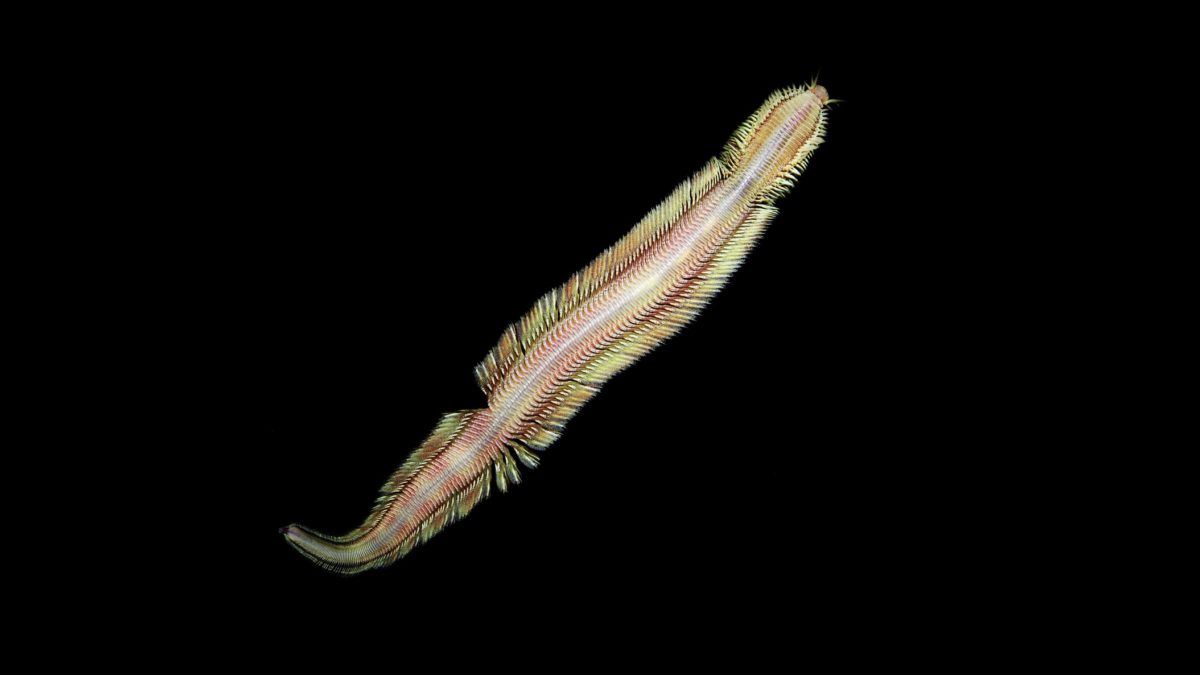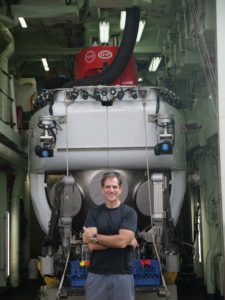New Deep-Sea Worm Discovered at Methane Seep Off Costa Rica Named after Alvin Pilot Bruce Strickrott
 A live male specimen of the new species of deep-sea worm, named Pectinereis strickrotti after the lead Alvin pilot, Bruce Strickrott of WHOI who helped discover it. Its feathery appendages are called parapodia and carry the worm’s gills. (Photo by Ekin Tilic)
A live male specimen of the new species of deep-sea worm, named Pectinereis strickrotti after the lead Alvin pilot, Bruce Strickrott of WHOI who helped discover it. Its feathery appendages are called parapodia and carry the worm’s gills. (Photo by Ekin Tilic) March 6, 2024
The creature raises the number of new species found by scientists studying these seemingly inhospitable ecosystems to 48
Woods Hole, Mass. -- Woods Hole Oceanographic Institution (WHOI), along with UC San Diego’s Scripps Institution of Oceanography (Scripps) and other researchers, have discovered a new species of deep-sea worm living near a methane seep some 50 kilometers (30 miles) off the Pacific coast of Costa Rica. The new species was described in a study published in the journal PLOS ONE, on March 6.
The worm, named Pectinereis strickrotti, was named after WHOI’s Bruce Strickrott, lead pilot for the famed deep-sea submersible Alvin, who was instrumental in the effort to locate and collect the creature.
Greg Rouse, a marine biologist at Scripps and curator of the Scripps Benthic Invertebrate Collection, led the study. Rouse and his colleagues have encountered roughly 450 species at the Costa Rican methane seeps since 2009, with this latest discovery bringing the number of those species that were new to science to 48. These impressive stats underscore how much more there is left to learn about these ecosystems as well as their biological importance, said Rouse.
Strickrott and Rouse first encountered the new species in 2009 at a depth of around 1,000 meters (3,280 feet) during a dive in the Alvin human-occupied submersible, which is operated by WHOI and owned by the U.S. Navy.
“We saw two worms near each other about a sub’s length away swimming just off the bottom,” said Strickrott. “We couldn’t see them well and tried to creep in for a closer look, but it’s hard to creep in a submarine and we spooked them.”

Bruce Strickrott, lead pilot for WHOI's Alvin, stands in front of the deep-sea submersible during a research cruise in 2022. A newly identified species of deep-sea worm, Pectinereis strickrotti, has been named in Strickrott’s honor. (Photo by Ken Kostel, ©Woods Hole Oceanographic Institution)
Finally, in 2018 the team was able to return to Costa Rica’s methane seeps with Alvin. On a dive to the same spot the worm was first sighted, known as Mound 12, Strickrott, who was piloting the sub with two scientists riding inside as observers, was astounded to encounter six or more individuals of the unidentified species they first saw there nearly a decade earlier. For some reason, the worms were much less skittish than they were in 2009 and, using a five-chambered vacuum canister device on Alvin known as the “slurp gun,” they carefully collected several specimens as well as images and video – enough to formally describe what proved to be a new species.
“The way this thing moved was so graceful, I thought it looked like a living magic carpet,” said Strickrott. “I’m honored that Greg [Rouse] saw fit to name this species after me, it means a lot.”
Pectinereis strickrotti is a 10-centimeter-long (4-inch) member of the ragworm family (Nereididae). Ragworms are a group of around 500 species of segmented, mostly marine worms that look like a cross between a centipede and an earthworm. They have elongated bodies with rows of bristled appendages called parapodia on their sides and a hidden set of pincer-shaped jaws that can be extended for feeding. Many species of ragworm also have two distinct life stages: atoke and epitoke. In these species, the worm spends most of its life on the seafloor, often in a burrow, as a sexually immature atoke, but in their life’s final act they transform into sexually mature epitokes that swim up off the bottom into the water column to find mates and spawn.
The team was able to collect three male Pectinereis strickrotti epitokes and part of one female. Following their successful collection, the team used the specimens to conduct anatomical analysis and to study the worm’s DNA to establish its evolutionary relationships within the ragworm family. The specimens now reside in Scripps’ Benthic Invertebrate Collection and the Museo de Zoología at the Universidad de Costa Rica.
Compared to most ragworms, Pectinereis strickrotti is unusual in several ways. First, it lives in the deep sea, while the majority of its evolutionary kin inhabit shallower waters. Second, its parapodia are covered in gills, while most ragworms absorb oxygen through their parapodia without the aid of true gills. The males had large spines at the end of their tails, which Rouse said might have something to do with reproduction but would require further study. Finally, owing to the total darkness at 1,000 meters (3,280 feet) under the sea, the new species is blind. Rouse said the worms probably have keen senses of smell and touch to help them navigate their inky world.
Pectinereis strickrotti has robust, even fearsome-looking jaws, but Rouse said their diet is still unknown and that the species could just as easily be feeding on bacteria as larger fare like other worms. Though its coloration would be a moot point in life, given its pitch-black habitat, Rouse said the worm appeared rosy under Alvin’s lights, and that this was probably due to the color of its blood.
Methane seeps are parts of the seafloor where the powerful greenhouse gas methane escapes from rocks or sediment on the seafloor in the form of bubbles. Unlike deep-sea hydrothermal vents, methane seeps are typically not hotter than the surrounding water. But like hydrothermal vents, methane seep ecosystems are fueled by chemical energy rather than sunlight. This is because some microbes have evolved the ability to consume methane. The microbes that can make methane into food create the base of a food web that at the Costa Rican seeps is dominated by mussels, crabs, and soft-bodied polychaete worms like this new species, said Rouse.
Males of the new species of deep-sea worm swimming near the sea bottom off the coast of Costa Rica on November 2, 2018. (Video courtesy of Erik Cordes, Temple U./NSF/HOV Alvin/2018 ©Woods Hole Oceanographic Institution.)
“We’ve spent years trying to name and describe the biodiversity of the deep sea,” Rouse continued. “At this point we have found more new species than we have time to name and describe. It just shows how much undiscovered biodiversity is out there. We need to keep exploring the deep sea and to protect it.”
In addition to Rouse, Sonja Huč, Avery Hiley, and Ekin Tilic of Scripps contributed to the study. Tulio Villalobos-Guerrero of the Centro de Investigación Científica y de Educación Superior de Ensenada is the study’s first author and conducted the primary anatomical analysis.
This research was supported by the National Science Foundation.
###
About Woods Hole Oceanographic Institution
Woods Hole Oceanographic Institution (WHOI) is a private, non-profit organization on Cape Cod, Massachusetts, dedicated to marine research, engineering, and higher education. Established in 1930, its mission is to understand the ocean and its interactions with the Earth as a whole, and to communicate an understanding of the ocean’s role in the changing global environment. WHOI’s pioneering discoveries stem from an ideal combination of science and engineering—one that has made it one of the most trusted and technically advanced leaders in fundamental and applied ocean research and exploration anywhere. WHOI is known for its multidisciplinary approach, superior ship operations, and unparalleled deep-sea robotics capabilities. We play a leading role in ocean observation and operate the most extensive suite of ocean data-gathering platforms in the world. Top scientists, engineers, and students collaborate on more than 800 concurrent projects worldwide—both above and below the waves—pushing the boundaries of knowledge to inform people and policies for a healthier planet. Learn more at whoi.edu.
